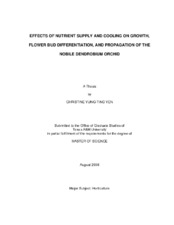| dc.description.abstract | Studies of Dendrobium Sea Mary ‘Snow King’ investigated the effect of
nutrient termination (1 Aug., 1 Sept., or 1 Oct.) and reapplication [at the
beginning, in the middle, immediately after, or 2 weeks after (relative to cooling),
or no nutrient reapplication] on growth and flowering, quantified cooling
requirements (10, 13, 15, or 18 °C for 2 to 6 weeks) for flowering, and
determined optimum nutrient termination (on the three above dates) and nutrient
rate (0.33, 0.67, or 1.33 g•L-1 15N-2.3P-12.9K) for producing single-node
cuttings. Regardless of reapplication stages, nutrient termination on 1 Oct.
caused taller plants with more nodes, more leaves, more flowering nodes, more
total flowers, and fewer aborted flowers than those being terminated earlier.
Only buds protruding above 2 mm from pseudobulb surface showed
differentiated floral structures. Plants with 1 Aug. nutrient termination had larger
flower primordia than those with 1 Oct., indicating flower differentiated earlier or
faster with an earlier nutrient termination. No reversion of reproductive to
vegetative buds arose due to either late nutrient termination or resumption of nutrients during cooling. Interactions between temperature and cooling duration
were significant on time required for anthesis and full flowering, recorded from
either beginning or completion of cooling, average flower number per flowering
node, and flower diameter. Increasing cooling duration from 2 to 6 weeks led
plants to reach anthesis and full flowering faster after cooling; however, the
increasing cooling duration actually extended total time for producing flowering
crops. Increasing temperature from 10 to 15 °C accelerated flowering after
cooling. Plants had more flowering nodes and total flowers when cooled at 10 to
15 °C than at 18 °C. The results suggest that 3 weeks of cooling at 13 or 15 °C
produce quality flowering plants that require less time to reach flowering. Plants
fertilized at 0.67 or 1.33 g•L-1 were taller with 18% more nodes and more leaves
than those receiving 0.33 g•L-1. Increasing nutrient rate with prolonged supply to
the plants caused more single-node cuttings to grow into vegetative shoots for
propagation, fewer cuttings to transition to flowering nodes, and less flower
abortion to occur. | en |


